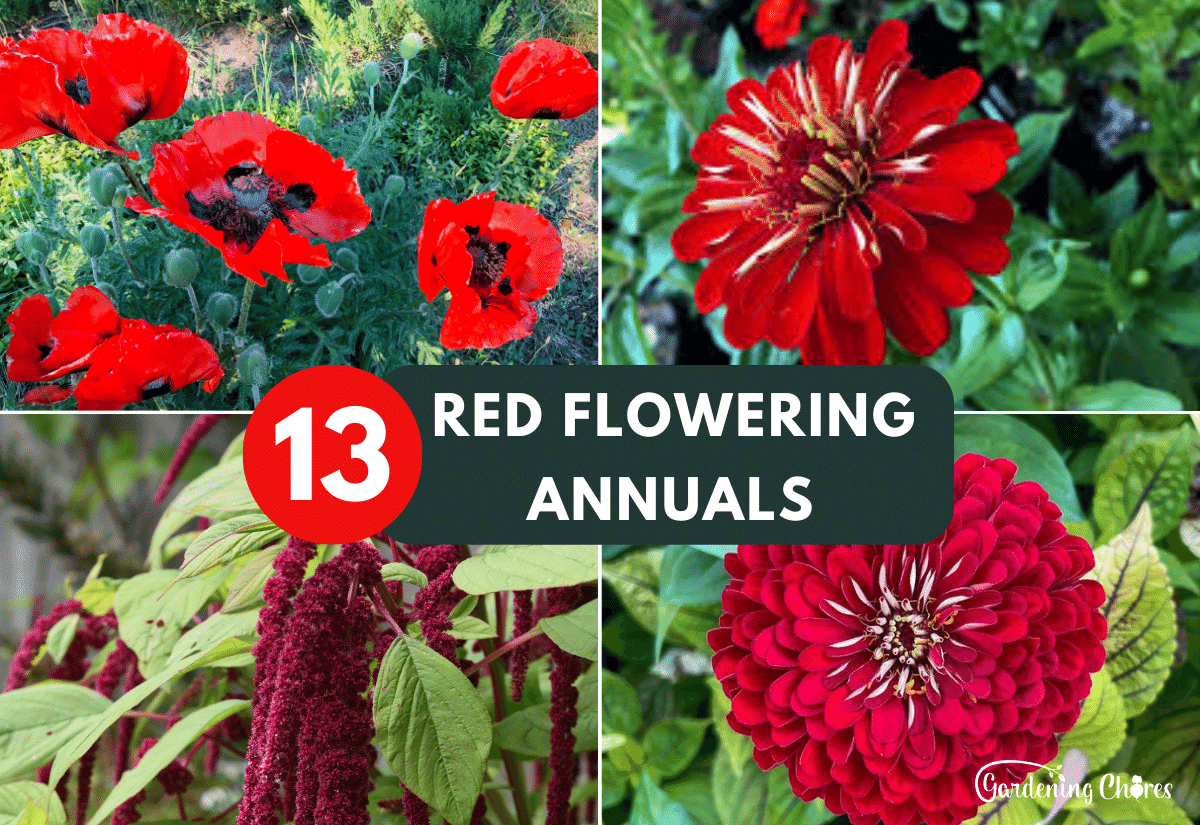
So, you want to make a bold and bright floral statement in your garden, and you want to do it with some decorative annual varieties… Then, the color you need is red, like love, like fire, like blood! Mass plant blooming plants in coral or cherry, or even more scarlet, and you can literally have an explosion of energy, and you can do it fast!
While quite a few perennials in this intense color need a hot climate to survive, red blossoming annuals can grow even in the coldest regions of Canada, and they usually have very long flowering times, even all through the season. This way, your beds and borders can flare up with energetic blossoms and lure loads of bees and butterflies as well.
Easy to grow and very generous with their floral displays in many shades of red, there are some really great annuals that can bring passion and heat to your green haven, and some perennials you can treat as annuals as well. And we want to show them all to you…
13 Hot and Vibrant Annual Varieties with Generous Red Blooms
And here they are: the best annual varieties with energetic red blossoms you can grow in your garden.
Shall we start our selection with an annual with really massive red flowers? Why not? So off we go!
1. ‘Bernary’s Giant Scarlet’ Zinnia (Zinnia elegans ‘Bernary’s Giant Scarlet’)
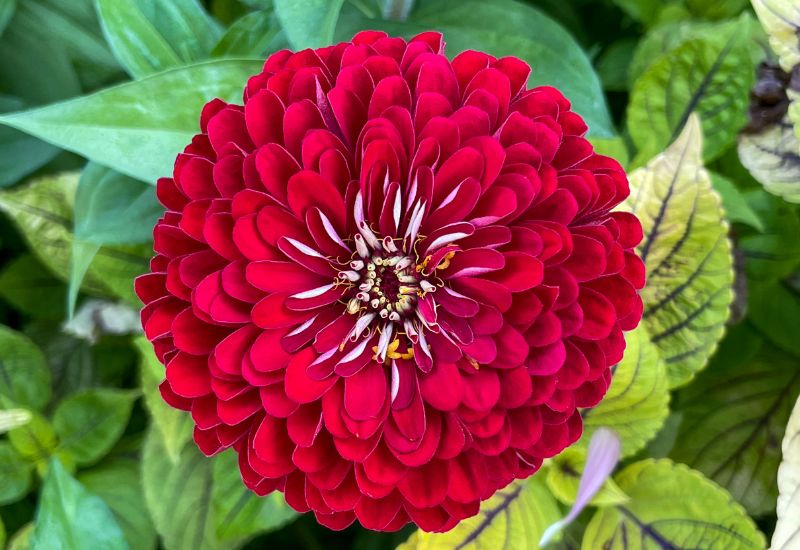
Zinnias are one of the world’s favorite flowering annuals, and there are a few varieties in red, but by far the most impressive is ‘Bernary’s Giant Scarlet’. Sometimes, cultivars get given misleading names, but this is really not the case! To start with, the tonality is really perfect: you will never see a more decided, bright and vibrant scarlet shade than on its blooms.
Lighting up your garden from early summer to frost,for months and months on end, the flowers are also on a massive scale for this genus, and not only… They are a whopping 6 inches across (15 cm)! They are also fully double and the ovate but slightly pointed petals are so regularly arranged that they create a decorative sculpture.
And, apparently, bees and butterflies appreciate this artistic touch… A thin ring of gold will also draw your eye in and add even more luminosity to these blossoms… Opening atop long and sturdy stems, this floral display also benefits from an elegant set of lance shaped and deep green leaves that provide texture and balance.
Low maintenance but very rewarding, ‘Bernary’s Giant Scarlet’ is also a winner of the Award of Garden Merit by the Royal Horticultural Society, so you can have a real bright red champion in your flower beds, borders or containers, and you can take it indoors as a cut flower!
2. Flowering Flax (Linum grandiflorum)
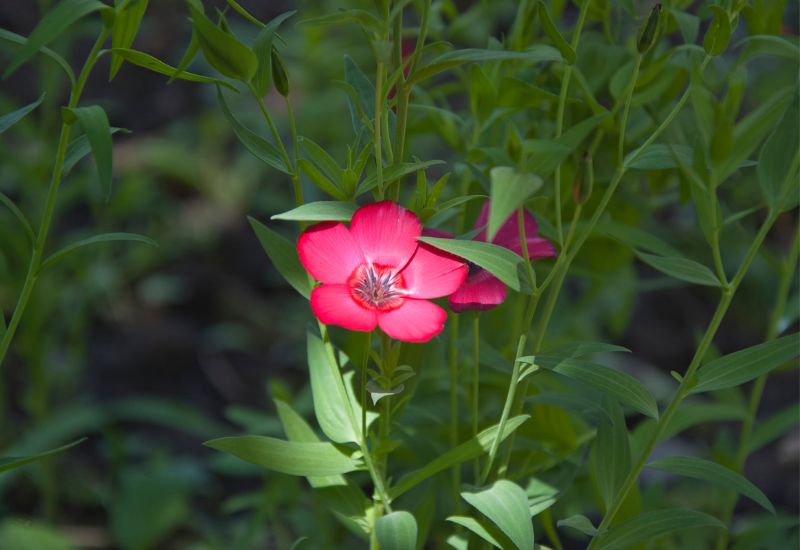
Native to North America, flowering flax is also called scarlet flax, but this name is not fully descriptive of its blooms… In fact, they display different shades of red… True, the inner part has darkish scarlet tonality, but then it turns to crimson, sometimes even with rosy touches.
Then again, at the very edges, it turns back to scarlet notes… The petals are rally delicate looking broad and rounded and only overlapping slightly, opening to a saucer, with a silky texture, very light and elegant…
In the center, you will also see dark rays lead you to five star like and bluish violet anthers! These blossoms will start appearing in early summer and lead you into the months of fall with their beauty, scattered on top of a finely textured, airy mound of fresh looking foliage.
The leaves are lance shaped, spaced along the stems, and bright green, but sometimes pale bluish as well. This is yet another annual that has received the coveted Award of Garden Merit by the Royal Horticultural Society.
Ideal for naturalized areas like wild prairies and meadows, Sun loving flowering flax is a must have variety for cottage gardens, but you can grow it in border fronts in any green space, as long as informal in style.
3. ‘Big Kiss Red’ Treasure Flower (Gazania rigens ‘Big Kiss’)
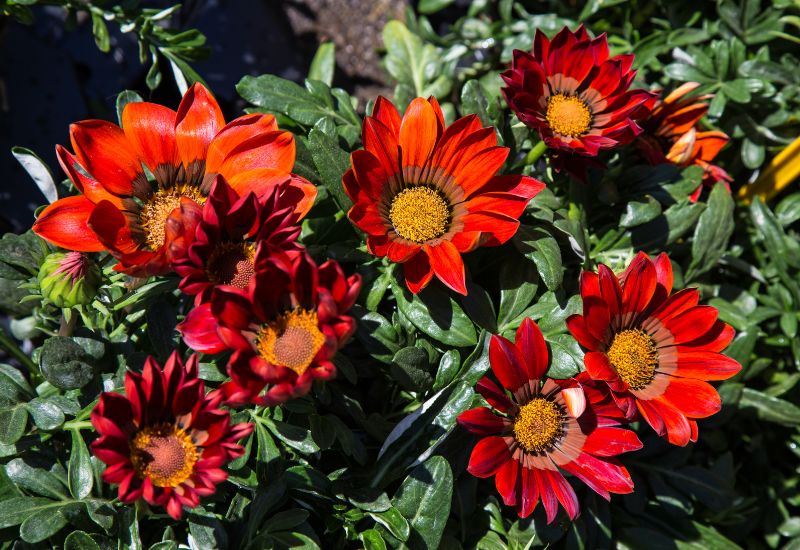
Gazania is actually a very tender perennial native to South Africa, but it is usually grown as an annual and treated as such. This genus specializes in hot and vibrant colors, and there are a few varieties in red, but ‘Big Kiss Red’ is an exceptional cultivar. To start with the notes of deep scarlet to carmine it hits are extraordinary; its dark and fully saturated shade is really exceptional.
Next, its flowers are even bigger than those of her sisters, reaching 5 inches across (12.5 cm)! The daisy like heads, however, retain the very artistic shaped of the regularly arranged petals, that end in pointed tips forming stars, or Sun like shapes! Fully flat, these blooms also have an incredibly luxurious texture, like velvet indeed! In the middle, you will see a a circle of pale orangish with dashes of black (deep purple) to trace its edges, and it contains a large golden eye of anthers!
This vibrant floral display will light up your garden from late spring to mid summer, and then intermittently thereafter, while the lovely rosette of deeply lobed and decorative rich green leaves at the base will keep you company till the end of the season.
A very showy annual variety, ‘Big Kiss Red’ treasure flower is a perfect choice for a big effect in low flower beds and containers. Despite its exotic personality, it will also suit traditional garden styles and coastal areas.
4. Foxtail Amaranth (Amaranthus caudatus)
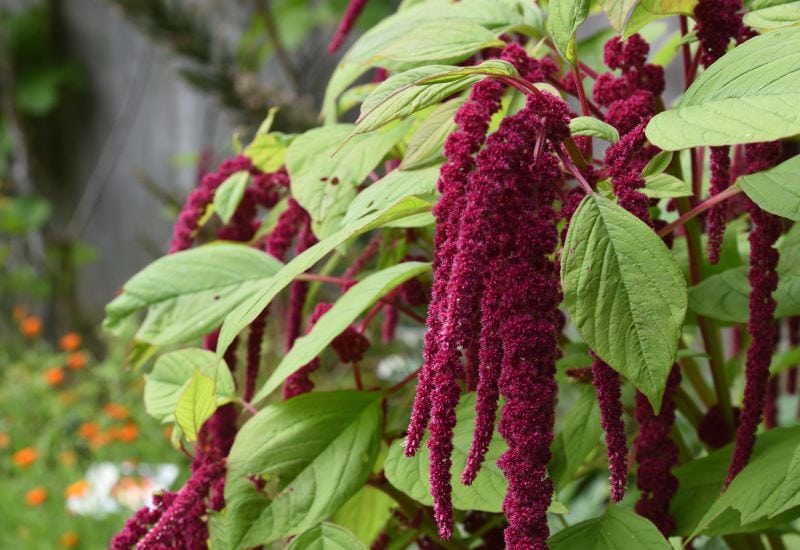
And now we meet a very unusually looking annual native to Africa, India and Peru (don’t ask why it comes from such disparate regions): foxtail amaranth.
In fact, it is also called love lies bleeding because its blooms look like fluffy drooping tails, and these are actually inflorescences packed with innumerable little flowers, and they can be a whopping 3 feet long (90 cm)! Descending sumptuously from upright stems, that grow high above your head, up to 8 feet into the air, these blossoms are a real wonder, and they will spark up a warm but cosy spectacle in your garden from early summer to fall.
And, of course, the exact tonality of red that it will offer you is amaranth indeed! Once the blossoms are spent. They are followed by by capsules that contain seeds that you can eat, that is if you beat the little birds that come to feed on them.
All this will happen against a dense and lush backdrop of lance shaped and pointed bright green leaves, each reaching 10 inches long (25 cm). Not bad to get all that in a single year!
Ideal for sunny herbaceous borders (at the back) or even hedges and naturalized areas, foxtail amaranth is an exceptionally large annual that’s easy to propagate by seed, unless it does it spontaneously…
5. ‘Crimson Red’ Stock Flower (Matthiola Incana ‘Crimson Red’)
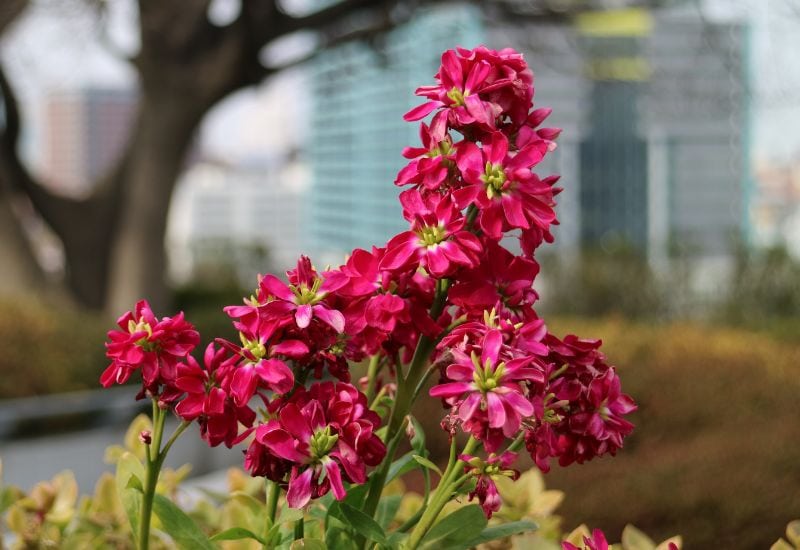
Also known as hoary stock, stock flower is a tender perennial mostly grown as an annual from the Mediterranean region which offers you an old world look and lots of interest early in the season.
There are many cultivars and varieties, in white, pink and purple, but among those in the color of love, ‘Crimson Red’ really stands out! In fact, it will start its floral display in late spring, and it will keep your garden aflame with vibrant energy into the middle of summer.
But it will also please your nostrils, because its blooms have a really strong, even heady fragrance! And of course, they are of the most intense crimson shade, but with white patches at the center, where you can see the golden yellow anthers as well…
Each flower head is about 2 inches across (5.0 cm) and with two or three rows of round petals that open fully to the Sun.
But what makes these blossoms a strong presence is that they are packed very tightly on an upright stalk, rising up from an equally dense clump of lush foliage underneath. The bright green leaves lance shaped, and they complete the natural bouquet effect that this short lived beauty creates.
‘Crimson Red’ Stock Flower will definitely bring lots of energetic blooms to your sunny herbaceous borders and flower beds, but also an “old world” feeling that makes it a very romantic presence.
An excellent cut flower it is definitely a must have annual in butterfly, cottage and English gardens. However, be careful handling it, because it can cause mild irritation to some people – just war gloves.
6. Red Moss Rose (Portulaca grandiflora)
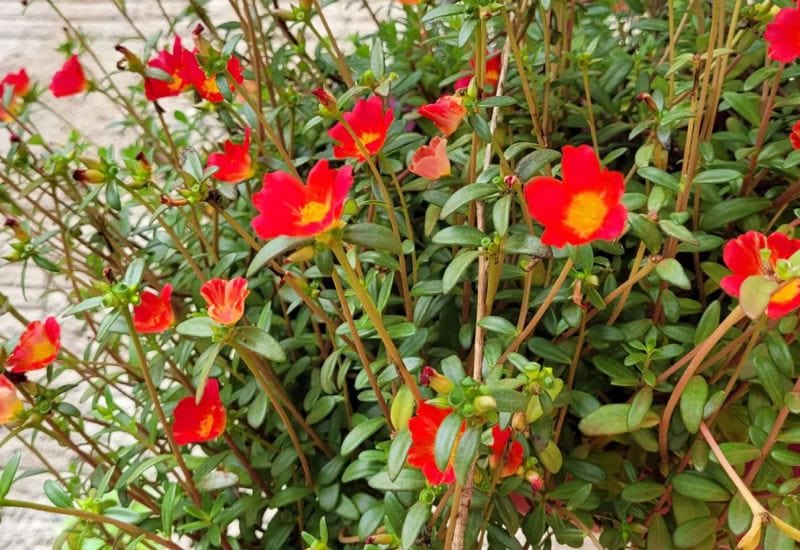
Moss rose is a very special plant indeed! In fact, this native species to Argentina, Brazil and Uruguay is actually an annual by nature, yet it is a succulent, and they are almost all perennials. But this means that you can grow it virtually anywhere and, not only will it survive, it will also bloom profusely…
What is more, as the name suggests, its flowers look like roses indeed, and they come in many colors… White, yellow, orange, pink, salmon, violet and even red. And when I say red, I mean super bright scarlet! The blossoms also open in the day and close at night, or they sleep on cloudy days, as those of Apteniado… So you can also forecast the weather by them, as I do…
Anyway, don’t worry, you won’t miss out in their abundant floral display, because the start in late spring and they never stop till the first frost! With single, semi double and double varieties, you can pick more traditional or more flamboyant looking blossoms, and they are about 1 inch across (2.5 cm).
All also have lovely crepe paper like petals, and they lovely and dense, finely textured foliage offers the perfect backdrop, with the thin, bright green and needle like small leaves that cluster elegantly in light mounds.
Ideal for edging, ground cover, containers, hanging baskets, border fronts and flower beds, moss rose will also grace rock gardens and naturalized areas with its red (or other color) flowers, and it will do it all through the season!
7. ‘Ladybird’ Annual Poppy (Papaver commutatum ‘Ladybird’)
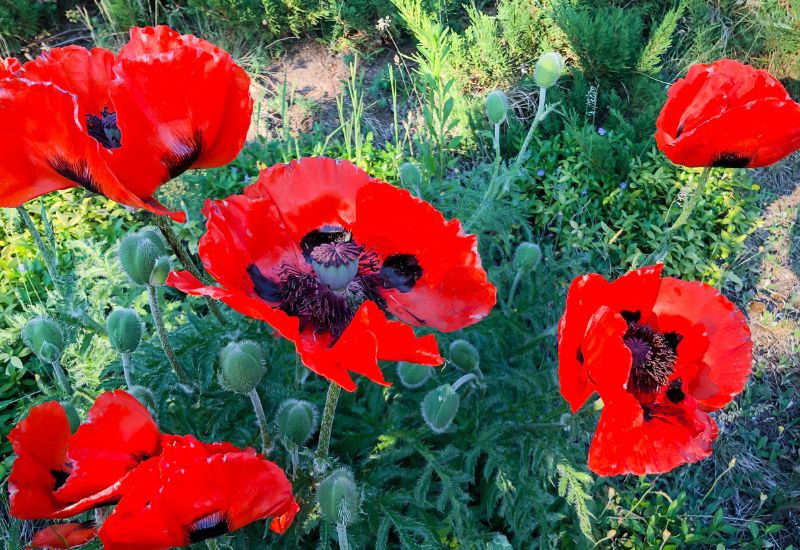
There’s no image more suggestive of summer days in the countryside than a sunny poppy field! And there are annual varieties as well, like the popular Papaver commutatum, native to the Caucasus and Asia Minor, but common all over many regions of the whole world, where it can grow spontaneous bringing flames of color that pop up among the wheat (at least, it used to, before herbicides).
The mostsought after variety is ‘Ladybird’, winner of the Award of Garden Merit by the Royal Horticultural Society, which is very aptly named indeed… Flowering between late spring and early summer, its blooms are round and saucer shaped, up to 3 inches across (7.5 cm), and with the iconic paper like and broad petals of this genus…
The blossoms will also surprise you with their super vibrant fire red color, but also with their black (very dark purple) large patches in the middle. They will also give you their very sculpturalcentral pistil, that looks like a capsule with rays at the top, which are actually the stigmas (or stigmata).
And it will turn into an actual capsule that looks like a little urn, filled with tiny seeds, once it has been pollinated by bees and butterflies. The deeply lobed leaves at the base form a lovely rosette in rich and bright green, and they are also edible, with a very sweet flavor, and they also have calming properties, as well being useful for an aching stomach.
A symbol of the victims of the First World War, ‘Ladybird’ annual poppy will work wonders in a naturalized area, like a wild prairie or meadow, but it can work perfectly well in a sunny flower bed or herbaceous border.
8. Red Impatiens (Impatiens spp.)
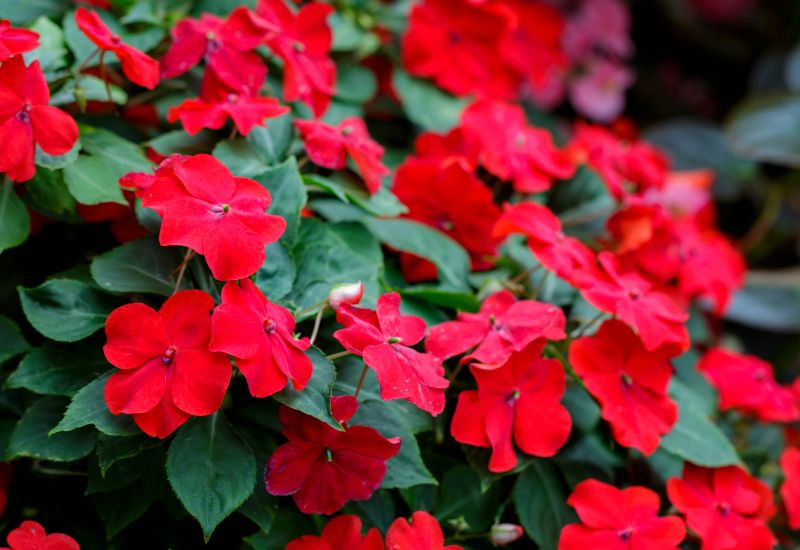
Impatiens is one of the most popular annuals all over the world, even if by nature it is actually a very tender perennial… Anyway, it is grown to give all its long lasting, dense and vigorous floral display within one season… And in fact, the flowers will start to open in spring, keep you smiling through summer, and only stop when the first frost comes…
Their round heads, flat and with heart shaped petals, with a little dent at the edges make them really charming, with a very traditional personality and they can reach 2 inches across (5.0 cm)…And there are a few varieties in red… For example, popular one is ‘Infinity Red’ has the exact color of fire, while ‘Compact Fire Red’ grows a but taller and it has bright scarlet as its choice.
For an intense crimson shade, choose ‘Sunpatiens Compact Deep Rose’ which also offers dark purple foliage, as does ‘Superpatiens Compact Hot Coral’, with a brighter tonality on the blossoms (yes, coral indeed). The all varieties will offer you a round mound of dense lance shaped and serrated leaves, on on which the floral displays will rest for months, starting mid green and reaching very dark hues.
Ideal for containers and window boxes red impatiens varieties will add a lot of energy but with a sweet look to flower beds as well, and they will do it all through the season, non stop and very profusely, even in deep shade!
9. ‘Empress of India’ Nasturtium (Tropaeolum majus ‘Empress of India’)
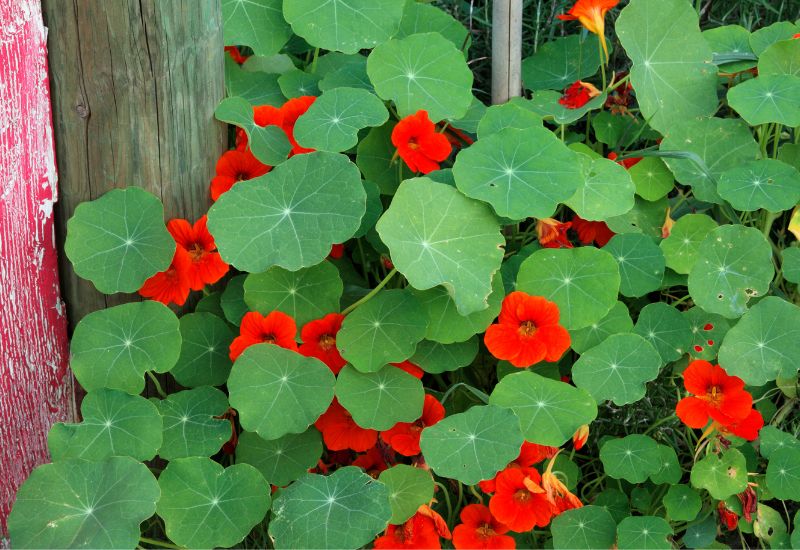
Now we meet an exotic looking annual variety which is actually a piece of gardening history… While Torpaeolum majus is native to Central and Southern Africa, the classic cultivar ‘Empress of India’ has been introduced back in Victorian times, and it has never stopped charming us ever since…
And of course it will, with its lovely funnel shaped blooms of the most spectacular and vibrant scarlet red that open wide at the mouth, giving you a round blossom with a golden throat that draws your eye in. As it does with butterflies, bees and other pollinators… Each flower is about 2 inches across, but they will come at different times according to where you grow them (and live)…
If you are in a warm winter region, the blossoms will appear in winter to spring, but if your garden is in an area with severe winters, they will warm up your summer and fall days… But wait, this lovely mound forming plant also has the loveliest foliage ever.
Fresh and tender looking the leaves are orbiculate (round and with the petiole in the middle), like little parasols, and very dark blue in color! But there is another gift that this sweet looking beauty has for you: all parts are edible, even raw, and they look and taste great in salads!
‘Empress of India’ nasturtium will really suit many positions and roles in any informal garden, from traditional to exotic… Grow it in flower beds, in your vegetable patch, in container or even in naturalized areas, and even in poor soil and it will never disappoint you. And it is excellent as ground cover as well.
10. ‘Red Sun’ Annual Sunflower (Helianthus annuus ‘Red Sun’)
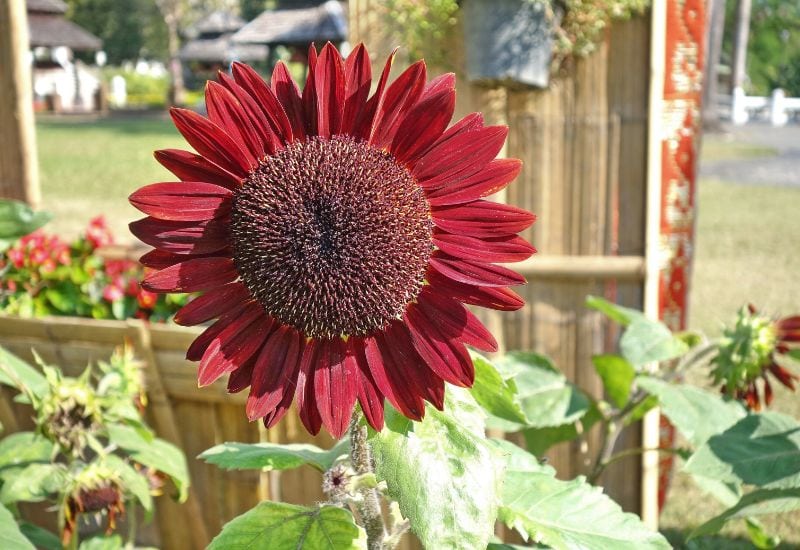
Get ready for a very, very bug experience! ‘Red Sun’ is a popular cultivar of annual sunflower, but instead of the traditional golden yellow, it offers you the color of fire and love! And on a large scale! In fact, the blooms are 8 inches across (20 cm), and real show stoppers.
They are actually inflorescences, as with all Helianthus varieties, and the ray petals display an incredibly deep ruby to even burgundy red, with a really sumptuous look, as they also have a very velvety texture! The central disk is large, and of a deep maroon shade, which adds to the intensity pf the whole flower…
And all this will happen high up in the sky, because it will grow to up to 6 feet within a season, till the blossoms light up your garden in mid and late summer. A brighter alternative could be its sister ‘Evening Sun’ which is orange to yellow at the tips, and on the scarlet range overall, and it is also larger (10 inches or 25 cm across) and taller (up to 8 feet, or 2.4 meters).
Both produce long and upright stalks with broad, light green and herbaceous looking, but also rough to the touch. And both will also attract lots of butterflies, bees and even birds, when they produce their energy packed seeds, which you can eat as well.
You can grow ‘Red Sun’ sunflower in a cutting garden, or at the back of sunny herbaceous borders, and it is ideal for a traditional looking space, especially if inspired by countryside landscapes. Alternatively, grow it on the sides of walls, to screen them with its energetic beauty.
11. Red Cosmos (Cosmos spp.)
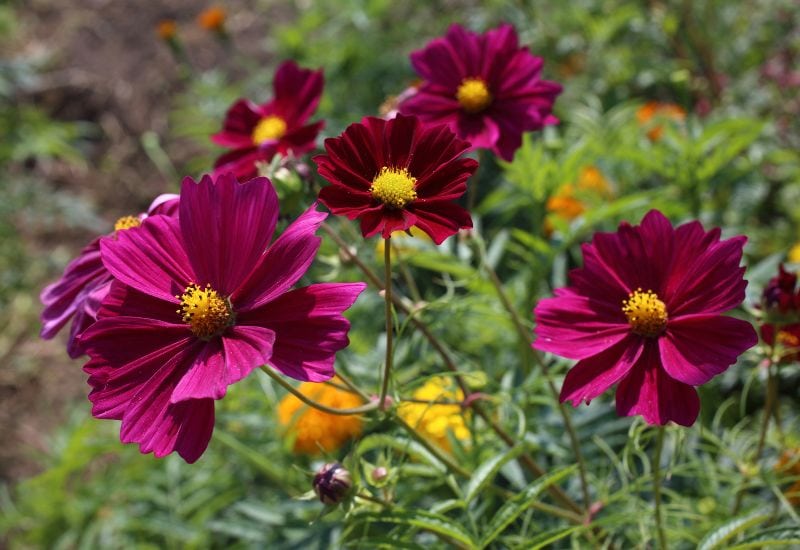
One of the most delicate looking annuals ever, cosmos varieties come in white, pink, rose and, of course, red as well! And we can see some of the very best, but they will all give you those amazing blossoms that seem to made of blotting paper, with elegant and light petals that form a flat and round disk with dented edges, up to 3 inches across (7.5 cm).
The golden center will always lighten up the color effect, and they will all attract lots of pollinators like butterflies and sometimes even hummingbirds! Then again, their bloom time is very long, starting as soon as spring is over, and continuing into the months of fall… So, you could go for the super luxurious ruby red ‘Rubenza’ (Cosmos bipinnatus ‘Rubenza’) whose flowers then turn dark rose as they mature, before they wilt.
This is a dwarf variety, never growing to more than 20 inches tall (50 cm). For a very luminous effect, look at the super energetic semi double ‘Cosmic Red’ (Cosmos sulphureus ‘Cosmic Red’) with brilliant scarlet and golden yellow dashes towards the center.
Or you could even pick chocolate cosmos (Cosmos astrosanguineus) for a deep burgundy shade, and a mouth watering fragrance of chocolate; it is actually a semi tender perennial, but you can treat it as an annual if you wish. All these plants also have very fine, feathery, almost fern like bright green foliage, which really suits the elegance of their floral display.
Any of these red cosmos varieties will call a wild prairie or meadow “home”, but they would feel quite comfortable bringing their vibrant but elegant blooms and foliage to beds and birders as well, especially in a natural looking space, like a cottage or English country garden, and they make good cut flowers as well.
12. Red Petunia (Petunia spp.)
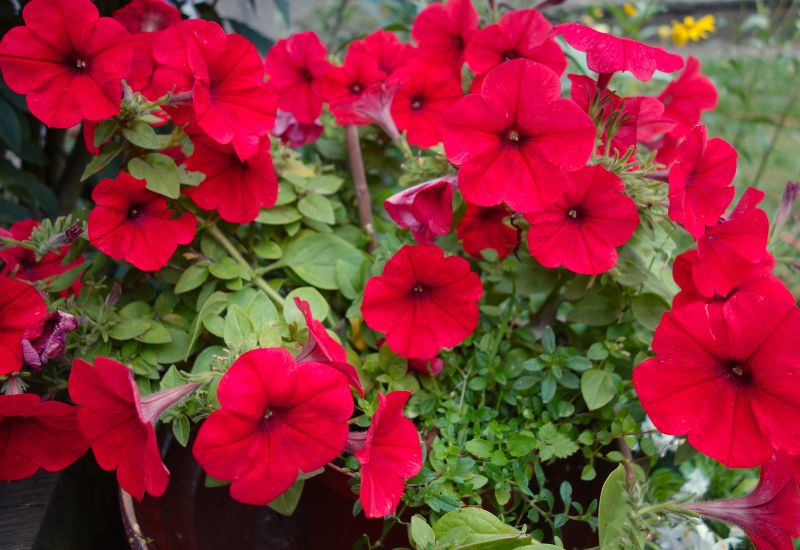
One of the most generous flowering plants of all, petunias are actually biennial, but most of us grow them as annuals. This is because they give their best performance on year one, while in their second year of life they have dry bits, and they look a bit unkempt.
However, if you don’t mind this and you want to give them a second chance… Their amazing floral displays literally cover the whole plant all the way from late spring to late fall, in a marathon of energy and beauty… And there are quite a few varieties in red, of course. One of the most striking is spreading ‘Easy Wave Red’, with carmine to rufous trumpet shapes flowers that open to about 1 inch across (2.5 cm).
‘Easy Wave Red Velour’, instead, will offer you a luxurious and intense, passionate carmine to rufus note through the season. On the other hand, ‘Shock Wave Red’ offers you bright scarlet and blossoms of up to 2 inches across (5.0 cm).
You can expect the same size from ‘Shock Wave Coral Crush’, which has a luminous crimson tonality instead, and from ‘Supertunia Black Cherry’ which hits notes of dark cherry (of course) to burgundy. And if you are looking for a trailing cultivar, ‘Supertunia Really Red’ may be your man, with amazing blood colored blooms.
All, however, have a really sumptuous velvet like texture and sticky stems with small, bright green and lance shaped leaves of them. However, you can hardly ever see the foliage under their super dense and amazing floral displays! And if hummingbirds come fluttering around, they won’t miss to visit your garden and feed on their sweet nectar…
Maybe the world’s favorite plant for hanging baskets, petunias in red can also bring the color of love and fire to other containers, but also flower beds, or you can use them for edging and even in a rock garden they could bring an intriguing twist…
13. ‘Dragon’s Breath’ Celosia (Celosia argenta plumosa ‘Dragon’s Breath’)
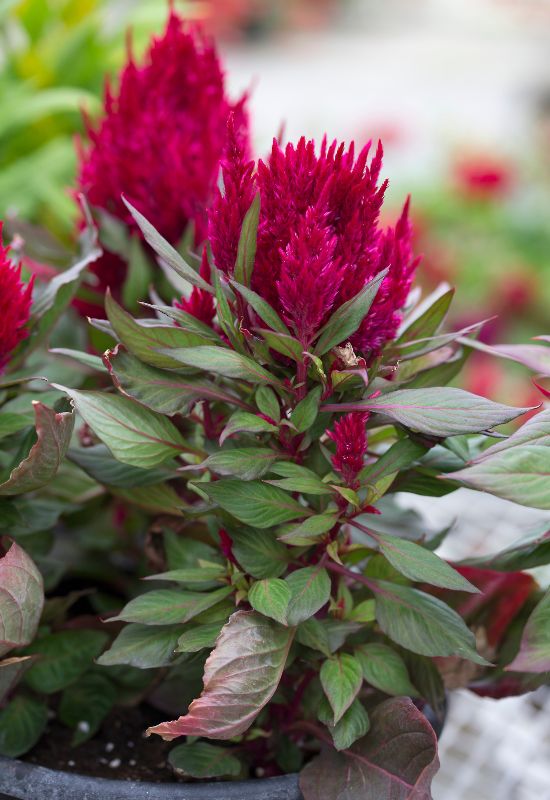
If you like this color, you will love ‘Dragon’s Breath’ celosia, and mot just for its suggestive name… There are other celosia varieties in shades of red, but this is exceptional, and in fact, it has won the Award of Garden Merit by the Royal Horticultural Society. To start with its plume like inflorescences that grow up towards the sky like flames are extra large for this genus, about 10 inches long (25 cm).
Packed with little florets that attract lots of butterflies and bees, this annual offers you the most luminous scarlet red you can ever see with its blossoms, for an incredibly intense effect. What is more, the blooms will last from early summer to fall, but there is a final twist…
The many lance shaped leaves that accompany this display from low down near the ground are of a dark ruby to burgundy tonality on the upper page. And the undersides of the foliage keep this shade for the veins, while the rest is bright green, providing a striking visual contrast.
‘Dragon’s Breath’ celosia will bring an extremely hot and vibrant note to your containers, flower beds and borders, or you could use them for a striking edging job in any informal garden.
Warm Up Your Garden with the Heat of Red Flowering Annuals!
These plants will only last a year – actually less, only a season – but in this short time, they will give you and your garden lots of amazing blooms of the most brilliant red tonalities ever. And they are all easy to grow, but very generous indeed!

Written By
Margie Fetchik
Margie and Arkansas native has an extensive background in gardening and landscaping. For the last 40 years, Margie has called the Colorado Rocky Mountains her home. Here she and her husband of 36 years raised three kids and owned a successful landscaping company. Margie has a CSU Master Gardener certification. She specialized in garden design & installation, perennial gardens, turf grasses & weeds, flower containers, and the overall maintenance of allHOA, commercial and residential accounts. She and her husband now reside in Denver and are excited about the new experiences’ city life holds.
